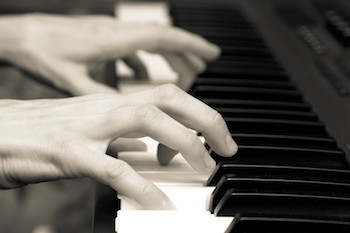Most chord progressions work best in the forward direction, and the longer a progression is, the truer that statement is. For shorter progressions, you’ll still often find that a progression sounds best when played beginning to end, but you’ll notice that playing them backwards isn’t a total wash-out. For example:
C Am F G C
That progression will work best if you play it beginning to end, but it also works — though possibly less successfully — when you play it back to front:
C G F Am C
It’s the Am-C part — the chords that used to be at the start of the progression — that sounds a little less satisfying. And I’ve written before about so-called palindromic progressions. They’re the ones that are the same both frontwards and backwards:
C Dm F Am F Dm C
 If all you need is chords to get your songwriting process started, “The Essential Secrets of Songwriting” eBook Bundle has tons of chords to experiment with. The bundle also comes with “Chord Progression Formulas”, which shows you how to create your own progressions in moments.
If all you need is chords to get your songwriting process started, “The Essential Secrets of Songwriting” eBook Bundle has tons of chords to experiment with. The bundle also comes with “Chord Progression Formulas”, which shows you how to create your own progressions in moments.
I want to focus in this post on progressions that are different, when played back-to-front, from their normal front-to-back direction. Different, but still work really well. Like this one:
C Bb F G C
When you play that as is, you get a standard progression that would work well in either a verse or a chorus. When you reverse it, you get a progression that sounds a tiny bit different, but is every bit as good:
C G F Bb C
So why are we concerning ourselves with progressions that work frontwards and backwards at all? What value comes from such progressions?
The main advantage to these kinds of progressions is that because they use the very same chords, they partner well as verse-chorus progressions. In other words, you could use the frontwards version for a verse progression, and the backwards version for the chorus. Those listening to your song won’t notice at all that you’ve done this. In a sense, it’s like invisible musical glue for your song.
Here is a short list of progressions that are different when played in opposite directions, but should work well as verse-chorus partners. It doesn’t really matter which direction you choose for your verse. It also won’t matter what tempo or songwriting style you use. It’s up to you to experiment with it.
Major key examples
- C F Dm G C
- C G Ab Bb C
- C Dm C Dm G Am G C
- C G Dm G Am F C
- C F Em Am F G C
Minor key and minor mode examples
- Cm Bb Ab Fm Cm
- Cm Gm Fm Eb Ab G Cm
- Cm Fm Cm/G G Cm/G Ab G Cm
- Cm Eb Fm Cm Ab Gm Cm
Written by Gary Ewer. Follow Gary on Twitter.

 “The Essential Secrets of Songwriting” eBook Bundle packages explore 11 principles of songwriting, and will take your own music to a new level of excellence. Right now, download a FREE COPY of “Creative Chord Progressions”, when you get the 10-ebook Bundle.
“The Essential Secrets of Songwriting” eBook Bundle packages explore 11 principles of songwriting, and will take your own music to a new level of excellence. Right now, download a FREE COPY of “Creative Chord Progressions”, when you get the 10-ebook Bundle.











Pingback: Progressions in Opposite Directions Make Great Verse-Chorus Partners - The Hit Songwriting Formula | The Hit Songwriting Formula